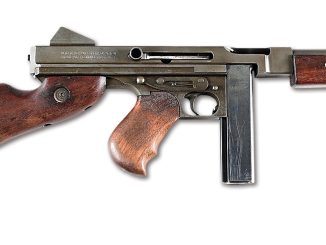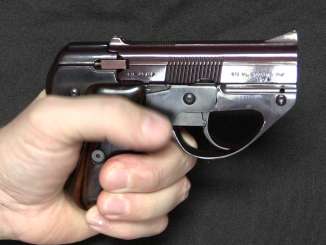Elisha Collier is probably the best-known name in flintlock revolvers – to the extent that any flintlock revolvers are well known. Because of the great cost and required skill to manufacture a functional repeating flintlock handgun without modern machine tools, these weapons were never common, but they were made by a number of gunsmiths across Europe. Collier and a fellow American gunsmith named Artemis Wheeler developed this particular type (the specific contributions of each party are not known), and Collier patented it in England in 1818. He proceeded to market the guns, which appear to have been made for him under contract by several high-end British gunsmiths (including Rigby and Nock).
Collier made three different basic types of guns. They share the main feature of a revolving cylinder which must be indexed manually between shots (seeing them while traveling in India was reportedly the inspiration for Samuel Colt’s idea to connect the mechanical functions of hammer and cylinder to invent the single action revolver). The first two patterns of Collier are flintlocks, differing in lock and cylinder design, as well as having slightly different mechanisms to self-prime. The third pattern was actually made as percussion guns, as Collier’s guns were being made right at the end of the flintlock period and the dawn of the percussion cap. In total, 350-400 guns were made, including 50-100 bought by the British military for use in India.
First Pattern Musket: https://www.rockislandauction.com/detail/69/220
Second Pattern Rifle: https://www.rockislandauction.com/detail/69/3165
Second Pattern Pistol: https://www.rockislandauction.com/detail/69/1114




The Collier longarms of course had the same problem all pre-metallic cartridge revolving longarms had. That is that a multiple discharge was nearly unavoidable, and would pretty much amputate the shooter’s off hand if the rifle was held normally.
Still, it was better than the Cochran or Porter turret revolvers, that could shoot you in the face with an MD.
To say nothing of the Porter turret rifle, with its top-mounted powder and ball magazine; a flashback to that could do an excellent impersonation of a fragmentation grenade right in your face.
cheers
eon
For chain-fire control, how about a steel plate deflector in front of the cylinder that would redirect the mis-fired bullets, such as off to the shooters right side and 45 degrees down toward the ground? Would the potential spall coming back at the shooter’s face be worth the price of saving his hand?
Black powder firearms (modern replicas) is something that we should all perhaps take a closer look at, since they could soon be on their way to becoming the only 2nd-Amendment compliant firearms left.
Maybe I’m being overly pessimistic, but California and Nevada citizens just voted for more gun control yesterday (after a long blitzkrieg of anti-gun lobbying), but it was nice to see that Maine voters said ‘NO’ to their state’s ballot proposal. It’s kind of hard to believe that in a notoriously “wild west” state where gambling and prostitution have always been legal, private (dealer-less) gun sales are now outlawed.
The most likely result of such a shield would be it fracturing and adding to the shrapnel that hits the off hand.
There are only two really practical safeguards against this. One is a vertical foregrip like the Thompson M1921 that keeps the off hand below the cylinder.
The other is one that was actually used on some of the LeMat carbines. A sheet-steel tube slightly larger than the cylinder, open at both ends, surrounding the barrel like the forearm of a later automatic rifle like the G3 and coaxial with the cylinder. In event of an MD, all the bullets pass through the tube and out safely, only being a threat to whoever or whatever you were shooting at anyway.
Of course, none of this changes the problem with all revolving long arms. Namely, that barrel-cylinder gap being right in front of the shooter’s nose.
Better hope it’s “in time”.
cheers
eon
” Namely, that barrel-cylinder gap being right in front of the shooter’s nose.”
Which can be solved by using gas-seal design, Nagant 1895 revolver is good known example of gas-seal metallic-cartridge, Mexican Pieper revolver-carbine less known, but there was also percussion revolver using similar mechanism – namely SAVAGE-NORTH PERCUSSION .36 CALIBER NAVY REVOLVER
http://armscollectors.com/mgs/savage_north.htm
Over the years, a lot of Savage-Norths have been wrecked internally by people who thought they worked just like the double-trigger Tranter.
On the Tranter, you can pull the long lower trigger first to cock the hammer and index the cylinder, then pull the smaller firing trigger for a single-action letoff. The effect is much like the set trigger on a target rifle.
You can also pull both triggers together for what is in effect a double-action shot, the rear trigger operating the hammer and cylinder just fractionally before the front trigger sears off the hammer.
A British officer is reputed to have objected to the Tranter on the grounds that “you can’t expect a man to play a cornet-a-piston in the middle of a fight”. Which actually was the reason for the “double-action” mode. Like an Adams, you just keep pulling through on the trigger.
That officer would really have hated the Savage-North. It had to be operated like the Tranter in “single-action” mode every time. First pull the ring trigger to operate the cylinder and hammer, then pull the front firing trigger to sear it off.
If you pulled both together, you stood a good chance of breaking the internal parts. Literally.
The U.S. (Union) Marines were issued Savage-Norths just at the beginning of the American Civil War for riverine duties on the Missouri, Mississippi, and etc.
After early experiences with the Savage-North’s peculiarities, they returned them to store, and instead requested (and got) Colt and Remington single-action revolvers, mostly Army-type .44s.
The Savage-Norths sat in store for another thirty years before they were bought up by Francis Bannerman in New York. A reprint 1920 Bannerman catalog I have shows them available in “unused” condition with full accoutrements for $2 each.
cheers
eon
You may find it interesting: C. P. Bedford: Collier and his revolvers [http://americansocietyofarmscollectors.org/wp-content/uploads/2013/05/B024_Bedford.pdf] (American Society of Arms Collectors).
Are they all made with pattern welded barrels? Hard to see but I think I saw traces of spirals on them.
May I suggest that many Collier customers were already familiar with flint-locks and reluctant to shoot new-tangled percussion guns?
And perhaps wisely, having recently fought two wars against the British, they may have also been aware of the problems occupations and blockades can cause, especially for critical munitions. Like flint, galena is a common mineral that can be mined, and the lead extracted and cast, and black powder made from naturally-occurring substances.
Making percussion caps, however, would be by far the greatest challenge for any backwoods rifleman (who may have by then regretted ‘upgrading’ from flintlock).
The trappers of the fur-trade era (1820s to 1840s)on the Great Plains and up into the Pacific Northwest tended to use flintlocks for exactly this reason. Flints or chert could be found in various places, and the friendly natives always knew where those places were, because they made arrowheads and other tools from them.
(Incidentally, here in Ohio, at the place known as Flint Ridge, a man knapping flints was considered inviolate. Two tribes might be at war with each other, but Flint Ridge was always neutral ground.)
The “Hawken” rifle, in percussion form, actually only came along in the late 1830s, when the Hawken brothers opened up their shop in St. Louis. This was toward the very end of the era of the “voyageurs” and etc.
The single most common rifle with the fur traders was probably the U.S. Model of 1816 .54 caliber flintlock. It in turn was a development of the Harper’s Ferry Model of 1803 .54 caliber flintlock rifle used by the Company of Exploration commanded by Lewis and Clark.
Smaller in caliber than the typical military rifles and muskets of its day (they averaged .69 to .75 cal.), half-stocked, and largely based on the “Pennsylvania/Kentucky” type civilian rifle, the 1803 was essentially the M-16 of its day; the most advanced military rifle on Earth, literally the “bleeding edge” of small-arms technology.
It worked well enough to get Lewis and Clark “There And Back Again”, as well as spawning the 1816 model that the fur traders swore by well into the percussion era.
As the old saying goes, if it ain’t broke, don’t fix it.
cheers
eon
I think that the flintlock smooth bore would make probably the best apocalyptic survival/ forage firearm for the same reasons. The ability to keep it fed from mostly natural sources is a real plus.
Falling hammer should activate a block for the cylinder not to move backward during firing.
Agreed. It appears that somebody forgot the possibility that the gun may be used in a wildly changing scuffle rather than in a shooting gallery. If that thing indexes backwards, “OH CRAP!” [somebody gets run through with a spear]
Some detailed info here; http://americansocietyofarmscollectors.org/wp-content/uploads/2013/05/B024_Bedford.pdf
Here’s a really old revolver belonging to a norwegian museum.
https://www.youtube.com/watch?v=cdlecO3gyOo
http://digitaltmuseum.no/011022448966
I was hoping you would do a video on those. I’ll have to add that to the ‘build a non functional replica’ pile, as I’m not bidding.
I don’t fancy all those flint sparks all over the place, and multiple chambers, looks like a good way to separate your face.
You just had to remind me why the Colt revolving rifle was ultimately not accepted by the US Army. Chain-fire incidents blew off the victims’ hands and/or faces. It was just as bad with the Lindsey double musket, which explains why users never wanted superimposed powder loads… or am I wrong?
Nope. In fact, most of the surviving Civil War Lindsay rifles and pistols around today show evidence of considerable wear on the left hand cone and hammer (that fired the rear charge) and almost none on the right-hand one (that fired the front charge).
This strongly indicates that they were being used simply as single-shot arms, ignoring the superposed load function entirely.
As for the Colt Revolving Rifle Musket and etc., the best remark was made by one of Sam’s own salesmen who was trying to sell them down South before Fort Sumter;
The General Gist mentioned, BTW, was named States Rights Gist (no, really), by his father, Nathanial Gist. He commanded the South Carolina militia until he was killed in action at the Battle of Franklin in 1864;
https://en.wikipedia.org/wiki/States_Rights_Gist
cheers
eon
Dang Eon!
There you go messing with politics!
Hah!
Hah!
Local gun-control lobbiers interpret the US Constitution’s Second Ammedment to affirm the right to bear muzzle-loading flintlocks.
Now you find an obscure REPEATING muzzle-loading ….. er …… front-of-cylinder-loading flintlock. If gun-control lobbiers a get their way, I predict that Collier production will resume.
Hah!
Hah!
If I really wanted to mess with people’s heads, I’d tell them to look up the Danish espingole from around 1780;
http://www.bevfitchett.us/firearms-curiosa/images/3039_38_168.jpg
A “roman candle” arm with replaceable firing chamber/”magazines”, they were apparently standard issue with Danish army units until well into the percussion period, and came in both standard musket (i.e., shoulder arm) size as well as “swivel” or “rampart” guns with bores of up to one and a quarter inches (1.25 cal or about 32mm).
Each “firing tube” held ten “rounds”. You locked it in, pulled the trigger, and BAMBAMBAMBAMBAMBAMBAMBAMBAMBAM- flip the lever, yank it out, shove another one in, snap the lever back down, recock and reprime, pull trigger, and off you go again.
The effective RoF works out to about 50 to 60 R/M. Not much below the practical RoF of a modern selective fire rifle like the M4.
Moral; people who write or demand laws regarding firearms rarely know much if anything about firearms. Especially the history of same.
cheers
eon
“front-of-cylinder-loading”
For metallic cartridge/machine weapon using this method see Rikhter R-23 autocannon.
https://en.wikipedia.org/wiki/Rikhter_R-23